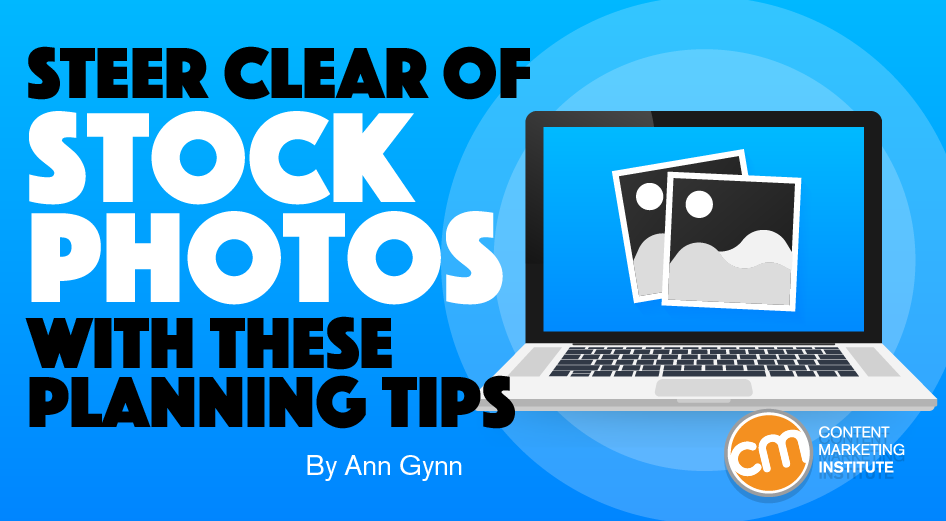MARKETING
Steer Clear of Overused Stock Photos With These Planning Tips and Resources

Marketers use a lot of images.
In an average week, 42.8% of surveyed marketers publish at least five visuals, and 40.8% use two to five images, according to a Venngage study.
Sourcing and organizing all those images take up a lot of the content marketing’s team time. That’s why so many teams rely on image banks filled with inexpensive (but sometimes clichéd or less than ideal) options.
You can cut down that work and end up with better images with some planning. Try these tips to create your own “stock” photography library and update your list of other stock resources.
Plan to do more with the images you’re already capturing
Many companies create customer stories, profiles, case studies, and testimonials. If your company does, find out whether a professional photographer will be shooting images to support it. Then, plan to enlist the photographer to capture a few extras.
Consider this photograph in a Stearns Bank customer story about Danielle Bennett, who works for a property group that sought the bank’s help in financing a senior living community:

A cursory review indicates this seems to be the only image of Danielle or her office in their digital marketing materials. But imagine if Stearns had turned this need for a customer story image into a photo shoot to capture several “stock” images for other content, such as blogs and social media. For example, with the subject’s permission, the photographer could have created images, such as a woman working on a computer, an office with glass walls, or a close-up of a hand grasping a pen and writing in a notebook.
TBH Creative regularly does that kind of multi-task photo shoots for the firm and its clients, says Joy Olivia Miller, a content strategist at the agency. (Joy worked with Pulitzer Prize-winning photographer Don Dry early in her career.)
The photographer takes images for websites, social media, presentations, email campaigns, signature graphics, case studies, downloadable content offers, and so on. They also may shoot one-off assets for other marketing and advertising content, such as store window posters, in-store digital displays, events, banners, and booths.
“We are able to get so much out of these branded photo shoots … because we do a lot of planning up front,” Joy says.
Get more out of branded photo shoots by planning to capture #images for more than one #ContentMarketing asset or medium, says Joy Miller of @tbhcreative via @AnnGynn @CMIContent. Click To Tweet
ADVERTISEMENT
9 Key Trends for 2022
What will truly make your content stand out, be unforgettable, and speak to your audiences in 2022?
CMI and PlayPlay interviewed 24 veteran content experts from companies like Nasdaq, SAP, Prudential, Zoom, and Convince & Convert to bring you this guide, which analyzes what you need to know about these important trends. Hear from digital marketing influencers such as Kim Garst, Matt Navarra, Joe Pulizzi, Mark Schaefer, Neal Schaffer, and more!
How to make the most of a photo shoot
Joy shared the planning tips she relies on for efficient photo shoots:
- Aim for timeless imagery. Make sure subjects don’t wear trendy clothes or patterns that indicate the images’ date. Simplify backgrounds and ask the subjects to wear clothes in brand colors.
- Do a lighting test before the shoot to make sure the space works for your photographer’s needs. Will a backdrop and lights fit? Are there sufficient outlets? If not, is natural light enough to create the feel you want even on a gray day?
- Prep the props. For example, if a person will be using a computer in the photo, is the screen ready? Does it show proprietary data you wouldn’t want viewers to see? Do you have another sweater or jacket ready to swap out to achieve a different look on the model?
To make the most of your photographer’s time and ensure you get sufficient images for your primary and secondary content uses, follow this advice from Joy:
- Shoot in more than one direction. Capture images in vertical and horizontal formats.
- Shoot close-ups and wide shots to have more flexibility with the images.
- Set up scenes to accommodate adding subjects or messages later. For example, if an executive isn’t available for a team shot, leave space for her in the picture. Or shoot a blank screen or whiteboard where you can add and change product photos and messages.
- Get routine shots of your company. For example, get a picture of your building to use on your website and Google My Business profile.
- Don’t rely solely on the photographer. Take your own photos to give viewers a behind-the-scenes view. You can share them to show your viewers a glimpse of the subjects in more relaxed settings.
When you receive the images from the photo shoot, you can use them for the primary purpose and categorize them so they’re accessible in a visual content library when content marketers and others need an image for another purpose.
TIP: Ensure all images taken at a photo shoot are owned and licensed by you for commercial use, says Kamyar Shah, business consultant.
Ensure all #images taken at a photo shoot are owned and licensed by you for commercial use, says @bsnscnslt via @AnnGynn @CMIContent. Click To Tweet
Skip the ‘stock’ stock sites
Of course, it takes time to build your in-house image library. Even if you have one, you may need to turn to commercially available stock photography occasionally. Almost 30% of marketers in the Venngage survey say they use stock photos, but only 8.9% of that group said those stock photos helped them reach their marketing goals.
Almost 30% of marketers say they use stock #photos, but less than 10% of those feel the stock photos helped them reach their goals, according to a @Venngage study via @AnnGynn @CMIContent. Click To Tweet
The problem? Stock photography can appear unoriginal. Marketers often rely on the same-old, same-old images from the most popular stock imagery sites. Your audience has probably seen that guy standing in front of the conference table on multiple websites. That happy family? Yes, they show up in various scenarios in a half-dozen content assets from six different companies.
Another problem? Your audience doesn’t see themselves or people who are different from them. Though progress is being made, white people dominate the options, as do stereotypical roles and families. And that’s a mistake.
Microsoft Advertising’s research, The Psychology of Inclusion and the Effects in Advertising, found over 60% of people are more trusting of brands and think those brands are more authentic when they reflect diversity in their ads. That same survey also found that the purchase intent for the “most inclusive” ad – featuring people across age, gender, and ethnicity who all had some form of a disability – was 13 points higher than for the “most appealing” ad and 23 points higher than all the ads shown.
“We need more inclusive photos and more photos with equal power,” says marketer Penny Gralewski.
We need more inclusive photos and more powerful photos in #ContentMarketing, says @virtualpenny via @AnnGynn @CMIContent. Click To Tweet
Try these diverse image collections
To help in that process, here are some go-to sites for inclusive and diverse stock imagery:
- CreateHER Stock features “melanated women,” says Penny, who learned about the site from Christine Michael Carter at Content Marketing World.
- She Bold Stock comes recommended by Anita Kirkbride of Twirp Communications, who says: “The photos are bright and well laid out. There is a great diversity of people in the images.”
- AllGo specializes in photography of plus-sized people, and Picnoi includes diverse collections of minority people from all walks of life (recommended by Zach Blenkinsopp of Digital Roofing Innovations).
- WOCinTech features women of color in tech; Mocha Stock includes multicultural photography and illustrations (recommended by business consultant Kamyar Shah).
- Nappy focuses on Black and Brown people (recommended by Herbert Lui of Wondershuttle).
- The Gender Spectrum Collection from Vice focuses on trans and nonbinary models; Representation Matters lists of diverse stock photo sites (recommended by Richard Lubicky of RealPeopleSearch).
- Unsplash offers a vast beautiful library that credits the photographers and is easily searchable; Pexels offers some unusual alternative images (recommended by Beth Kapes of Moving Words Into Action).
Ask for the images you need
If you see a photographer’s images that have some relevancy to what you need, reach out to the photographer to see if they have another version, says Joy Olivia Miller of TBH Creative.
For example, if you need a picture of a college student in a wheelchair and see an image of a young adult in a wheelchair behind a desk, reach out to that photographer and ask whether they have other versions. If you see a photo showing an older male doctor treating a young woman patient, ask the photographer if they have other pictures with different models. “Sometimes they mix up their shoots and have people swap in and out,” Joy says.
Doing more with planned photo shoots and expanding your stock photo options will improve your visual content development. You’ll appreciate having more relevant image choices for your content assets.
And more importantly, your audience will appreciate seeing original, diverse, and inclusive imagery that’s relevant to them.
HANDPICKED RELATED CONTENT:
Cover image by Joseph Kalinowski/Content Marketing Institute







![How to Create A Website to Sell Products In 8 Steps [+6 Expert Tips] How to Create A Website to Sell Products In 8 Steps [+6 Expert Tips]](https://articles.entireweb.com/wp-content/uploads/2024/10/1727868370_How-to-Create-A-Website-to-Sell-Products-In-8.webp-400x240.webp)
![How to Create A Website to Sell Products In 8 Steps [+6 Expert Tips] How to Create A Website to Sell Products In 8 Steps [+6 Expert Tips]](https://articles.entireweb.com/wp-content/uploads/2024/10/1727868370_How-to-Create-A-Website-to-Sell-Products-In-8.webp-80x80.webp)








You must be logged in to post a comment Login